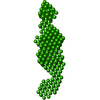+Search query
-Structure paper
| Title | RAID3--An interleukin-6 receptor-binding aptamer with post-selective modification-resistant affinity. |
|---|---|
| Journal, issue, pages | RNA Biol, Vol. 12, Issue 9, Page 1043-1053, Year 2015 |
| Publish date | Jul 12, 2016 |
 Authors Authors | Florian Mittelberger / Cindy Meyer / Georg H Waetzig / Martin Zacharias / Erica Valentini / Dmitri I Svergun / Katharina Berg / Inken Lorenzen / Joachim Grötzinger / Stefan Rose-John / Ulrich Hahn /   |
| PubMed Abstract | Aptamers are an emerging class of highly specific targeting ligands. They can be selected in vitro for a large variety of targets, ranging from small molecules to whole cells. Most aptamers selected ...Aptamers are an emerging class of highly specific targeting ligands. They can be selected in vitro for a large variety of targets, ranging from small molecules to whole cells. Most aptamers selected are nucleic acid-based, allowing chemical synthesis and easy modification. Although their properties make them interesting drug candidates for a broad spectrum of applications and an interesting alternative to antibodies or fusion proteins, they are not yet broadly used. One major drawback of aptamers is their susceptibility to abundant serum nucleases, resulting in their fast degradation in biological fluids. Using modified nucleic acids has become a common strategy to overcome these disadvantages, greatly increasing their half-life under cell culture conditions or even in vivo. Whereas pre-selective modifications of the initial library for aptamer selection are relatively easy to obtain, post-selective modifications of already selected aptamers are still generally very labor-intensive and often compromise the aptamers ability to bind its target molecule. Here we report the selection, characterization and post-selective modification of a 34 nucleotide (nt) RNA aptamer for a non-dominant, novel target site (domain 3) of the interleukin-6 receptor (IL-6R). We performed structural analyses and investigated the affinity of the aptamer to the membrane-bound and soluble forms (sIL-6R) of the IL-6R. Further, we performed structural analyses of the aptamer in solution using small-angle X-ray scattering and determined its overall shape and oligomeric state. Post-selective exchange of all pyrimidines against their 2'-fluoro analogs increased the aptamers stability significantly without compromising its affinity for the target protein. The resulting modified aptamer could be shortened to its minimal binding motif without loss of affinity. |
 External links External links |  RNA Biol / RNA Biol /  PubMed:26383776 / PubMed:26383776 /  PubMed Central PubMed Central |
| Methods | SAS (X-ray synchrotron) |
| Structure data |  SASDA88: |
 Movie
Movie Controller
Controller Structure viewers
Structure viewers About Yorodumi Papers
About Yorodumi Papers



